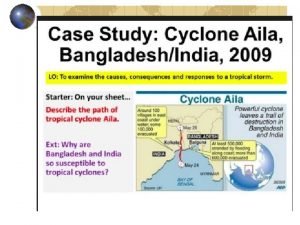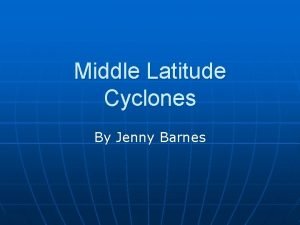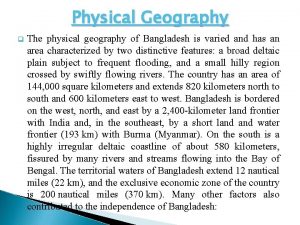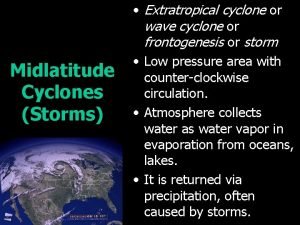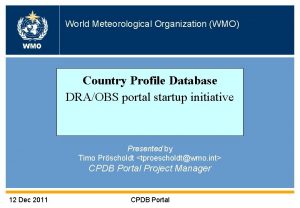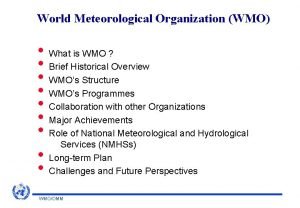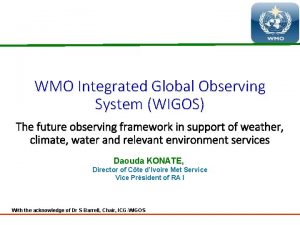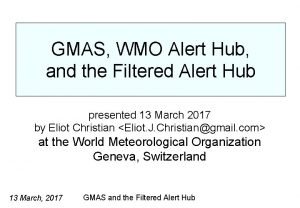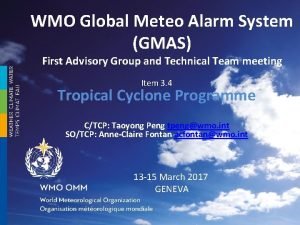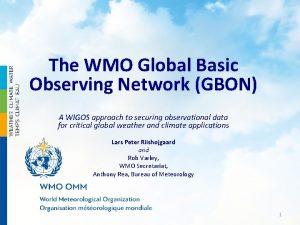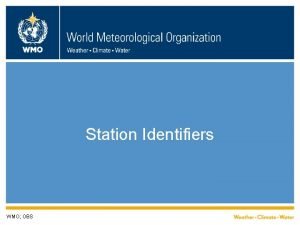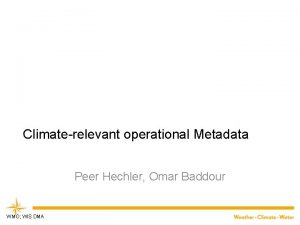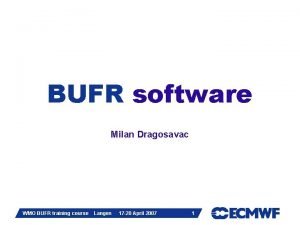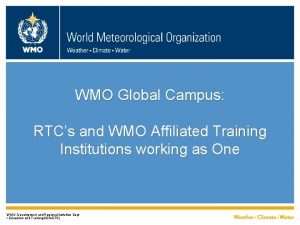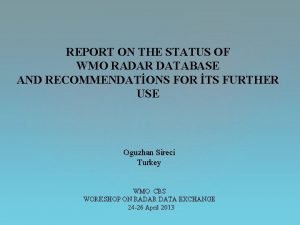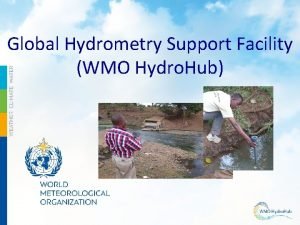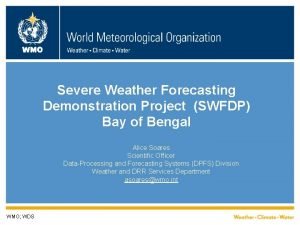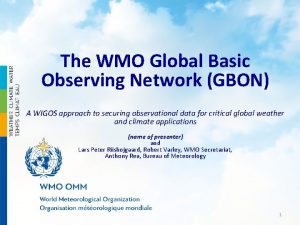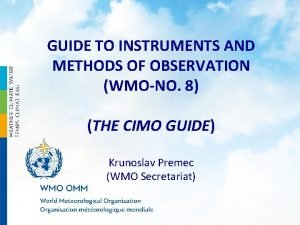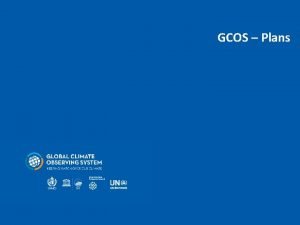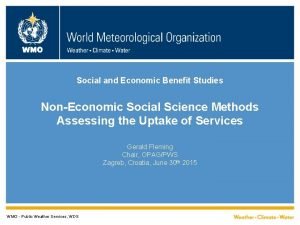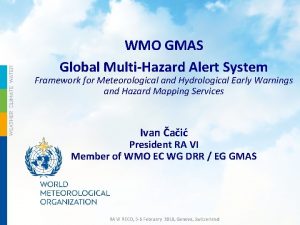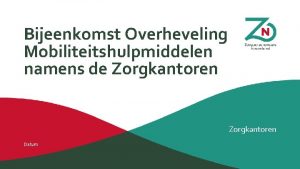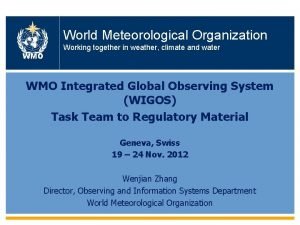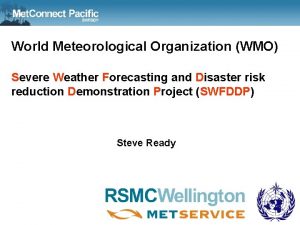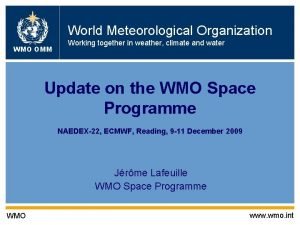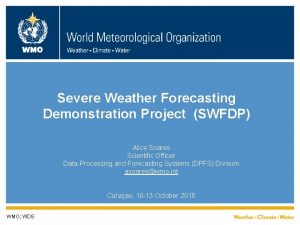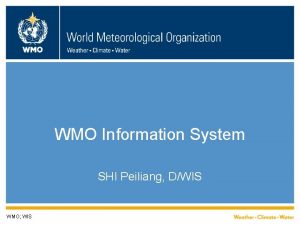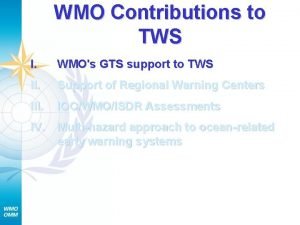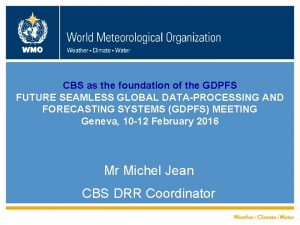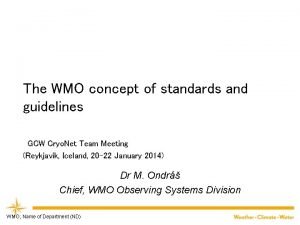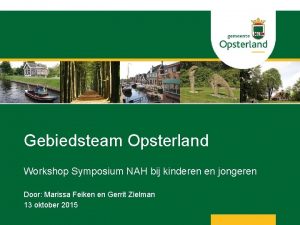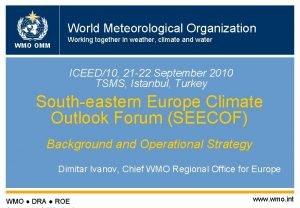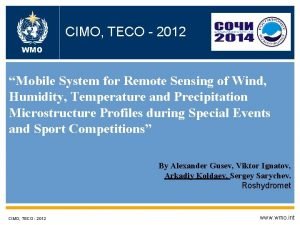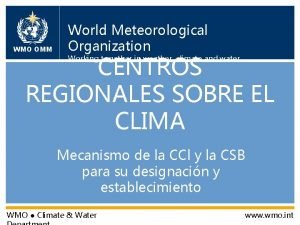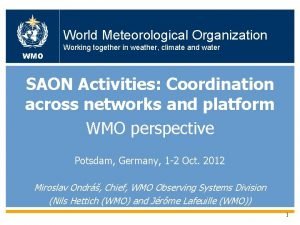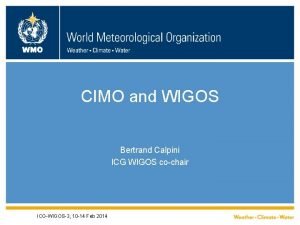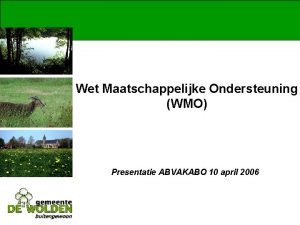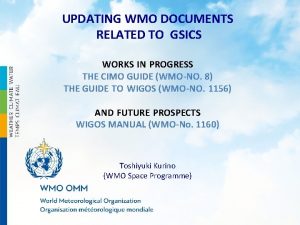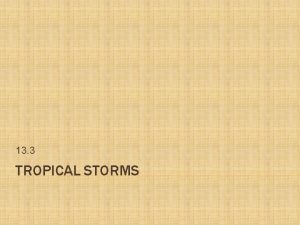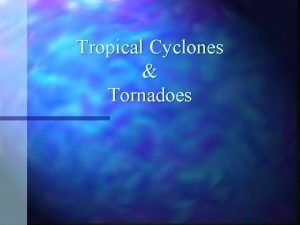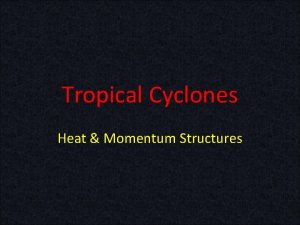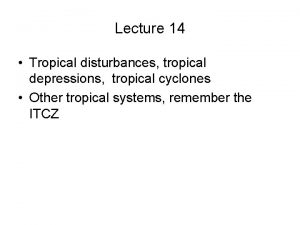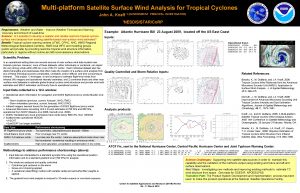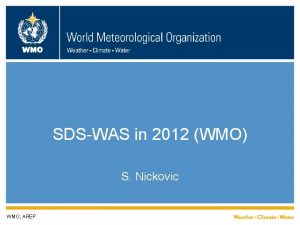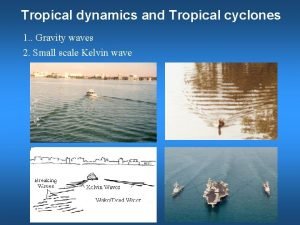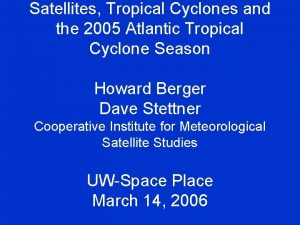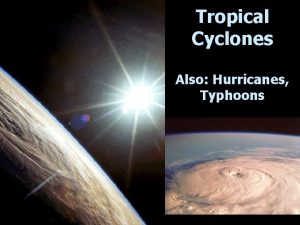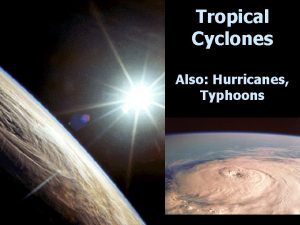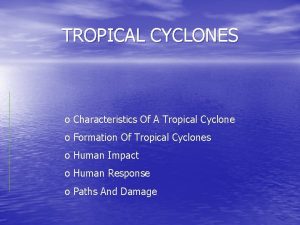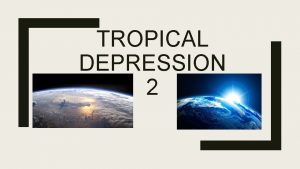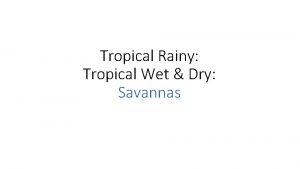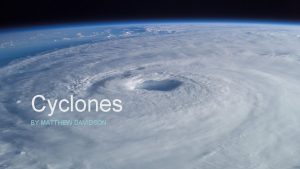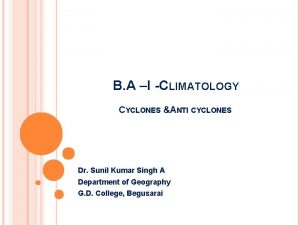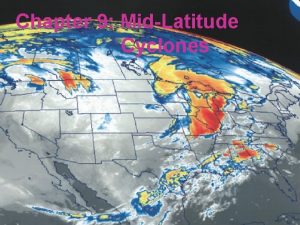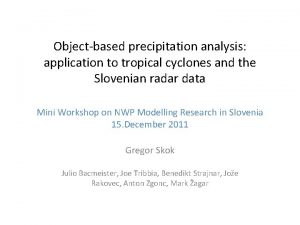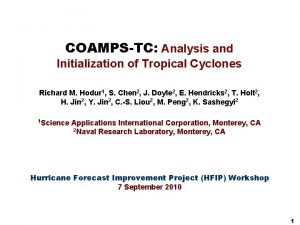Satellite Analysis of Tropical Cyclones in India WMO














































- Slides: 46

Satellite Analysis of Tropical Cyclones in India WMO International Workshop on Satellite Analysis of Tropical Cyclones (IWSATC), Honolulu Hawaii, 13 – 16 April 2011 Suman Goyal , Satellite Meteorology Division, India Meteorological Department, Suman_goyal 61@yahoo. co. in

Presentation Layout v Introduction v Satellite operations in India v Tropical Cyclone Analysis in India v Problems and prospects v Future Aspects

SOME FACTS ABOUT CYCLONES v Out of 80 global annual number - four form over Bay of Bengal – two / three intensify to severe ones v Minimum No. of cyclones in a year - One (1949) v Maximum No. of cyclones in a year – Ten (1893, 1926, 1930, 1976) v Out of total disturbances - 35% intensify to Cyclones 16 % intensify to SCS 7% intensify to VSCS v Peak activity – November followed by May v Ratio of TCS between Bay of Bengal and Arabian Sea – 4: 1 v Year to year variation - Quite large

SOME FACTS ABOUT CYCLONES (Cont’d) v Most vulnerable coast in the West Coast - South Gujarat coast. v Most vulnerable coast in the East Coast - 24 paraganas of West Bengal followed by Krishna & Nellore districts of AP. v Life period of a Tropical Cyclone is 5 -6 days. It will have hurricane intensity for 2 -4 days as against 6 days of global average. v Life period of the longest lived Tropical Cyclone in Indian seas is 14 days (2 -15 th Nov, 1886 & 16 -29 th Nov, 1964). v Life period of the longest lived Hurricane Ginger over Atlantic is 31 days during 1972. v Size of a Tropical Cyclone over Indian seas is 50 -100 km radius to 2000 km radius with average of 3º to 5º (300 – 600 km).

Frequency of Cyclonic systems over north Indian Ocean during 1891 -2007


INTRODUCTION Introduction v India has been quite active in satellite meteorology. First Indian polar orbiting Satellite Aryabhatta was launched on 19 April 1975 followed by two other Indian polar orbiters, Bhaskar-1 on 7 th June 1979 and Bhaskar-2 on 20 th November 1981 were launched. The first geostationary Indian Satellite with meteorological payload INSAT-1 A was launched on 10 th April 1982 and INSAT 1 B on 30 th August 1983.

IR 8507060300 Z /1 B

INSAT Series v v v INSAT -2 A the indigenously built satellite launched by India on July 1992. India launched INSAT -1 D on June 1990. INSAT -2 B launched by India on July 1993. INSAT -2 E the last satellite of the series was launched by India on 26 th May 1999. KALPANA -1 Satellite was launched on September 2002. INSAT -3 A launched on May 2003 by India.

Tropical Cyclone Analysis (1960 -1974) v Tropical cyclone analysis in delayed mode started from 1960’s after the launch of TIROS-1 in 1960. v Tropical cyclone analysis in India on real time started from 1963 onwards after the establishment of APT service in Bombay v As the number of satellite increased and Nephanalysis bulletins from USA and USSR were also being received which improved the Tropical Cyclone analysis in India.

Tropical Cyclone Analysis (1960 -1974) Contd…… v Pre Dvorak era (before 1975), Intensity was approximated by seeing the intensity and size of cloud pattern appearance of storm’s eye, its banding etc. .

Tropical Cyclone Analysis (1975 -1982) v. Systematic method started from 1975 onwards on real time after the formulation of Dvorak technique which gained widespread acceptance v Initially Dvorak technique was based on pattern matching concepts and only visible imageries were used for analyzing the tropical systems.

Earliest Satellite Records v By using this technique, post-mortem studies were done for the cyclones for the period 1967 -1971 by using pictures from the satellites ESSA-3, ESSA-9, ITOS-1 And NIMBUS-3 (D. K. Mishra, Hemraj, 1974) v. Conclusions from these studies were quite different than those by Dvorak. It may be because of lack of measurement techniques.


Synoptic Description Wind speed Cyclone (kt) attributed intensity in to synoptic terms of T. No. feature Wind Speed (kt) obtained from Dvorak’s technique Depresssion (including deep depression) 17 -33 T 1. 5 -3. 5 25 -30 Cyclonic storm 34 -47 T 4. 0 -4. 5 60 -75 Severe cyclonic storm 48 onwards T 5. 0 and above 85 kt and above

Inter Agency Difference in Position and Intensity of the Vortex Example : GIRI over Bay of Bengal During 20 -22 Oct, 2010 Date Time (UTC) Position (Lat / Long) Intensity 20 -10 -2010 0600 16. 5/91. 5 T 1. 0 0900 17. 0/ 91. 5 T 1. 0 1200 17. 5/ 91. 5 T 1. 5 1700 17. 5/ 91. 5 T 1. 5 2100 21 -10 -2010 0300 17. 5/ 91. 5 T 2. 0 0600 17. 5/ 91. 5 T 2. 5 1100 17. 6/ 91. 8 T 3. 0 1500 T 3. 0 1700 18. 0/ 92. 2 T 3. 0 2100 18. 2/ 92. 4 T 3. 5 Center(SS D-NOAA) SSDNOAA 17. 3/91. 4 T 2. 0 17. 4/91. 9 T 2. 5 17. 6/91. 4 T 3. 0 17. 9/92. 3 T 4. 0 18. 3/92. 3 T 4. 5 JTWC

Date Time (UTC) Position (Lat / Long) Intensity 22 -10 -2010 0000 18. 5/ 92. 6 T 3. 5 0100 18. 5/ 92. 6 T 4. 0 0300 18. 8/ 92. 8 T 4. 5 0600 19. 0/ 93. 0 T 5. 0 0900 19. 2/ 93. 1 T 5. 5 1200 19. 9/ 93. 3 T 5. 5 1400 20. 1/93. 3 Overland Center(SS D-NOAA) SSD- JTWC NOAA T 5. 0 18. 6/92. 8 T 6. 0 19. 4/93. 2 T 6. 5 T 6. 0 T 7. 0

JTWC Bulletin of GIRI

Very Severe Cyclone GIRI 22 Oct 2010 0900 UTC This distance is : 0. 35° deg Pattern: Eye Embedded Distance=0. 35 Eno= 3. 5 EAdj= 0 CF= Eno + EAdj =3. 5 BF= 2. 0 DT=CF+BF=5. 5

Other Inter Agency Differences v Some times systems were tracked by India Meteorological Department, but not by SSD NOAA and vice versa. v SSD NOAA is normally giving higher intensity at 2100 UTC as compared to IMD

Weaker Systems v. In weaker system center determination is difficult. In such cases Scatterometric winds from Oceansat 2 and Microwave imageries are helpful. Some times multiple centers are also seen in the satellite imageries.


Parameter Oceansat-II Quik. SCAT Frequency 13. 515 GHz 13. 4 GHz Wind speed range 4 to 24 m/s 3 to 20 m/s Wind speed Accuracy Better than 20% (RMS) 2 m/s Wind direction Accuracy 20º (RMS) 20º Resolution 50 X 50 km 25 km Swath 1820 km 1800 km

20 October, 2010 around 0300 UTC

Limitations v. Rapidly intensifying systems Dvorak technique fails. v. According to Dvorak Final T no. limits < T 4 change of half over 6 hours >T 4 change of 1 over 6 hours Example : Tropical Cyclone “GIRI” from 20 to 22 Oct 2010. Maximum Intensity reached 5. 5

Local variations to Dvorak (1984) T. No. /C. I No. T 1. 0 T 1. 5 T 2. 0 T 2. 5 T 3. 0 T 3. 5 T 4. 0 T 4. 5 T 5. 0 T 5. 5 T 6. 0 T 6. 5 T 7. 0 T 7. 5 T 8. 0 Wind Speed in Knots (Atlantic) 25 25 30 35 45 55 65 77 90 102 115 127 140 155 170 Wind Speed in Knots (IMD) <17 25 30 35 45 55 65 77 90 102 115 127 140 155 170

Limitation in Dvorak technique v. The technique is subjective and there are systematic variations between analysts but they are being sorted out by mutual discussions. v. Microwave imageries can be accessed through cyclone module of SYNERGIE and are helpful for centre determination.

Relation between Final intensity estimate and CI number v. The CI is same as the final intensity for developing cloud patterns. v. The CI differs from the final T-number for most weakening patterns, and also when redevelopment is indicated. vsatellite imagery, use of Mcidas or similar) For weakening cyclone CI is same for 12 hours, then hold CI ½ or 1 higher than T number as storm weakens.

Objective analysis of tropical cyclones v. In October 2009 ADT version 7. 2. 2 was installed in IMD with the help of SAC Ahmedabad. v. As an example some results are shown:

SATMET SSD-NOAA ADT-SAC CIMSS-ADT SAC-ADT-CIMSS-CENTER SAC-ADT-CIMSS-T 25 SAC-ADT-SATMET-29 APR SAC-ADT-SATMET_T 25 25 -05 -2009 08 25 -05 -2009 06 25 -05 -2009 04 25 -05 -2009 02 25 -05 -2009 00 24 -05 -2009 22 24 -05 -2009 20 24 -05 -2009 18 24 -05 -2009 16 24 -05 -2009 14 24 -05 -2009 12 24 -05 -2009 10 24 -05 -2009 08 24 -05 -2009 06 24 -05 -2009 04 24 -05 -2009 00 23 -05 -2009 18 23 -05 -2009 12 23 -05 -2009 06 23 -05 -2009 00 22 -05 -2009 18 22 -05 -2009 12 22 -05 -2009 06 22 -05 -2009 00 21 -05 -2009 18 21 -05 -2009 12 21 -05 -2009 03 4. 5 AILA-May 2009 4 3. 5 3 2. 5 2 1. 5 1 0. 5 0

SATMET SAC-ADT CIMSS-ADT SAC-ADT-CIMSS-CENTER SAC-ADT-SATMET-T 20 17 -04 -2009 21 17 -04 -2009 15 17 -04 -2009 11 17 -04 -2009 09 17 -04 -2009 06 17 -04 -2009 04 17 -04 -2009 02 17 -04 -2009 00 16 -04 -2009 22 16 -04 -2009 17 16 -04 -2009 15 16 -04 -2009 13 16 -04 -2009 11 16 -04 -2009 09 16 -04 -2009 07 16 -04 -2009 05 16 -04 -2009 03 16 -04 -2009 01 15 -04 -2009 23 15 -04 -2009 21 15 -04 -2009 16 15 -04 -2009 13 15 -04 -2009 11 15 -04 -2009 09 15 -04 -2009 07 15 -04 -2009 03 14 -04 -2009 21 14 -04 -2009 15 14 -04 -2009 09 14 -04 -2009 03 13 -04 -2009 21 13 -04 -2009 15 13 -04 -2009 09 13 -04 -2009 03 4 Bijli-Apr 2009 3. 5 3 2. 5 2 1. 5 1 0. 5 0


v. CI Pressure-wind relationship is not changed. It is continuing since 1976. Mishra & Gupta formula : Vm = 14. 2√∂p, where ∂P is Po – Pc (Pressure in outermost isobar – central pressure)

Wind pressure relationship with Intensity T. No. d. P ( h. Pa) Wind Speed (knots) T 2. 0 4. 5 30 T 2. 5 6. 1 35 T 3. 0 10. 0 45 T 3. 5 15. 0 55 T 4. 0 20. 9 65 T 4. 5 29. 4 77 T 5. 0 40. 2 90 T 5. 5 51. 6 102 T 6. 0 65. 6 115 T 6. 5 80. 0 127 T 7. 0 97. 2 140 T 7. 5 119. 1 155 T 8. 0 143. 3 170

Criteria for best track record v. Systems from T 1. 5 (Depression) onwards are entered in best track records but if Satellite Division declares T 1. 5 but Synoptic Division do not declares as Depression than it is not entered in best track.

SATELLITE BULLETIN DATED: 22/10/2010 TIME: 0300 UTC TCIN 50 DEMS 220300 SATELLITE BLLETIN BASED ON INSAT PIC OF 220300 UTC (. ) AREA OF RESPONSIBILITY: EQ TO 40. 0 N LONG 60. 0 E TO 100. 0 E (. ) SALIENT FEATURE: VORTEX OVER EC ADJ NE BAY FURTHER INTENSIFIED AND NOW CENTRED AT 18. 9 N/92. 9 E (. ) INTENSITY T 5. 0 REPEAT INTENSITY T 5. 0 (. ) EYE VISIBLE (. ) METEOSAT WINDS SHOWS WIND SHEAR IS BET 5 TO 10 KTS AND WIND SHEAR TENDENCY IS BET -10 TO – 20 KTS SHOWS FURTHER CHANCES OF INTENCIFICATION (. ) ASSTD BKN TO SOLID INT TO V INT CONVTN (CTT MINUS 81 DEG C) OVER BAY BET LAT 16. 0 N TO 21. 0 N EAST OF LONG 90. 0 E ARAKAN COT ADJ MYANMAR (. ) BKN M/LAYERED CLOUDS OVER J&K ADJ PAK N HP EXT N PJB AND OVER AREA BET LAT 36. 0 N TO 47. 0 N LONG 74. 0 E TO 87. 0 E IN ASSW WD OVER THE AREA (. ) NORTH: SCT LOW/MED CLOUDS OVER REST PJB REST HP N UTRKND E UP ADJ W UP AND ISOL OVER W HARY (. ) EAST: BKN LOW/MED CLOUDS WITH EMBDD MOD TO INT CONVTN OVER S ASSAM AND E BD (. ) BKN LOW/MED CLOUDS WITH EMBDD ISOL WK TO MOD CONVTN OVER REST PARTS OF THE REGIONAND BHUTAN EXCEPT SCT LOW/MED CLOUDS OVER BHR (. ) WEST: BKN LOW/MED CLOUDS WITH EMBDD ISOL WK TO MOD CONVTN OVER SE MP S M MAHA S KKN & GOA (. ) SCT LOW/MED CLOUDS OVER REST MP REST MAHA N RAJ AND S GUJ (. ) SOUTH: BKN LOW/MED CLOUDS WITH EMBDD MOD TO INT CONVTN OVER E TLNGN RYLSM ADJ NIK COTL KRNTK ANDAMAN IDS AND LKSWDP (. ) BKN LOW/MED CLOUDS WITH EMBDD ISOL WK TO MOD CONVTN OVER REST PARTS OF THE REGION EXCEPT SCT LOW/MED CLOUDS OVER S TN (. ) Continue….

BAY OF BENGAL & ANDAMAN SEA: SCT LOW/MED CLOUDS WITH EMBDD MOD TO INT CONVTN OVER REST EC BAY SW BAY AND WK TO MOD CONVTN OVER REST BAY ANDAMAN SEA GULF OF MARTABAN (. ) ARABIAN SEA: BKN LOW/MED CLOUDS WITH EMBDD MOD TO INT CONVTN OVER ARSEA BET LAT 9. 5 N TO 18. 0 N EAST OF LONG 67. 0 E (. ) SCT LOW/MED CLOUDS WITH EMBDD ISOL WK CONVTN OVER REST S ARSEA (. ) OUTSIDE INDIA: BKN LOW/MED CLOUDS WITH EMBDD MOD TO INT CONVTN OVER N SUMATRA STR OF MALACCA AND OVER INDIAN OCEAN BET EQ TO 5. 0 N EAST OF LONG 90. 0 E (. ) BKN LOW/MED CLOUDS WITH EMBDD ISOL WK TO MOD CONVTN OVER E TIBET ADJ CHINA REST MYANMAR ADJ THAILAND (. ) TOO: 22/0940 EF= TCIN 51 DEMS 220300 INTENSE PRECIPITATION ADVISORY BASED ON INSAT PIC OF 220300 UTC (. ) SCT INT PPTN LIKELY OVER J&K HP N PJB LKSWDP AP AND ISOL OVER KRNTK DURING NEXT SIX HOURS (. ) TOO: 22/0942 EF=

SPECIAL SATELLITE BULLETIN DATE: 22 -10 -2010 TIME: 0400 UTC TCIN 50 DEMS 220400 SPL SAT BLTN BASED ON INSAT PIC OF 220400 UTC (. ) VORTEX OVER EC ADJ NE BAY CENTRED AT 18. 8 N/92. 8 E (. ) INTENSITY T 4. 5 (. ) EYE VISIBLE (. ) METEOSAT WINDS SHOWS WIND SHEAR IS BET 5 TO 10 KTS AND WIND SHEAR TENDENCY IS BET -10 TO – 20 KTS SHOWS FURTHER CHANCES OF INTIFICATION (. ) ASSTD BKN TO SOLID INT TO V INT CONVTN (CTT MINUS 81 DEG C) OVER BAY BET LAT 16. 0 N TO 21. 0 N EAST OF LONG 90. 0 E ARAKAN COT ADJ MYANMAR (. ) TOO: 22/1015 EF=

Future Prospects § INSAT-3 D Satellite Scheduled to be launched in the 3 rd quarter of 2011 § Payloads § It has a 6 -channel Imager almost similar to GOES satellites of USA. § It has a 19 –channel Sounder similar to GOES satellites. § It has a Data Relay Transponder (DRT) similar to Kalpana-1 and INSAT-3 A.

INSAT 3 D Derived Products No. Parameters Input Channels 1. Outgoing Long wave Radiation (OLR) TIR -1, TIR -2, WV 10. Water Vapor Wind (WVW) WV, TIR -1, TIR -2 2. Quantitative Precipitation Estimation ( QPE) TIR -1, TIR -2, WV 11. Upper Tropospheric Humidity (UTH) WV, TIR -1, TIR -2 3. Sea Surface Temperature (SST) SWIR, TIR -1, TIR -2, MIR 12. Temperature, Humidity profile & Total ozone Sounder all channels 4. Snow Cover VIS, SWIR, TIR 1, TIR -2 13. Value added parameters from sounder products Sounder products 5. Snow Depth VIS, SWIR, TIR 1, TIR -2 14. FOG SWIR, MIR , TIR -1, TIR -2 6. Fire MIR, TIR -1 15. Normalized Difference Vegetation Index CCD 7. Smoke VIS, TIR -1, 2, MIR 16. Flash Flood Analyzer TIR -1, TIR -2, VIS 8. Aerosol VIS, TIR -1, TIR -2 17. HSCAS VIS 9. Cloud Motion Vector (CMV) VIS, TIR -1, TIR -2 18. Tropical Cycloneintensity /position AODT technique, TIR 1, TIR-2 TIR -

Megha-Tropiques mission of ISRO: Polar orbiting 1. To be launched in 2011 2. It shall have the following payloads a) Microwave Analysis and Detection of Rain and Atmospheric Structures(MADRAS), with five channels of microwave for estimation of atmospheric water parameters in the equatorial belt. b) SAPHIR microwave humidity sounder and radiometer of 6 channels for humidity profile. c) SCARAB-broadband radiation measurement for measurement of Radiation fluxes.

Channel of MADRAS & their related mission objectives Channel No. Frequency Polarization Spatial Resolution Mission M 1 18. 7 GHz H+V 40 Km Rain & wind speed over Oceans M 2 23. 8 GHz V 40 Km Integrated Water Vapor M 3 36. 5 GHz H+5 40 Km Liquid water in cloud, rain above sea M 4 89. 0 GHz H+V 10 Km Convective rain areas over land sea M 5 157. 0 GHz H+V 6 Km Ice at Cloud top



Buoys Network Government of India has established a National Data Buoy Programme (NDBP) at National Institute of Ocean Technology (NIOT), Chennai. Under this programme, twelve moored data buoys have been deployed from August’ 97 to February ’ 98 at a sea depth of 20 m to 4500 m and spread over Bay of Bengal and Arabian sea. Since 2002, the number has increased to 25

Cyclones over North Indian Ocean
 Distribution of tropical storms
Distribution of tropical storms What are middle latitude cyclones
What are middle latitude cyclones Physical geography of bangladesh
Physical geography of bangladesh Mid latitude cyclones characteristics
Mid latitude cyclones characteristics Air masses and fronts
Air masses and fronts Wmo cpdb
Wmo cpdb What is wmo
What is wmo Wigos
Wigos Alert hub
Alert hub Wmo gmas
Wmo gmas Wmo gbon
Wmo gbon Identifiers example
Identifiers example Omar baddour wmo
Omar baddour wmo Wmo bufr
Wmo bufr Wmo regional training centres
Wmo regional training centres Wmo global campus
Wmo global campus Wmo radar database
Wmo radar database Wmo hub
Wmo hub Wmo gdpfs
Wmo gdpfs Gbon wmo
Gbon wmo Wmo cimo guide
Wmo cimo guide Wmo strategic plan
Wmo strategic plan Introduction and acknowledgement
Introduction and acknowledgement Ipcc wmo
Ipcc wmo Ugly wmo
Ugly wmo Wmo 1150
Wmo 1150 Gmas wmo
Gmas wmo Wmo
Wmo Wmo
Wmo Wmo
Wmo Wmo severe weather
Wmo severe weather Wmo
Wmo Stefano nativi
Stefano nativi Swfdp
Swfdp Wis wmo
Wis wmo Wmo gts
Wmo gts Gdpfs wmo
Gdpfs wmo Wmo
Wmo Wmo regional training centres
Wmo regional training centres Gebiedsteam opsterland
Gebiedsteam opsterland Wmo omm
Wmo omm Wmo cimo
Wmo cimo Omm wmo
Omm wmo Wmo omm
Wmo omm Wmo cimo
Wmo cimo Wmo omm
Wmo omm Cimo guide
Cimo guide
